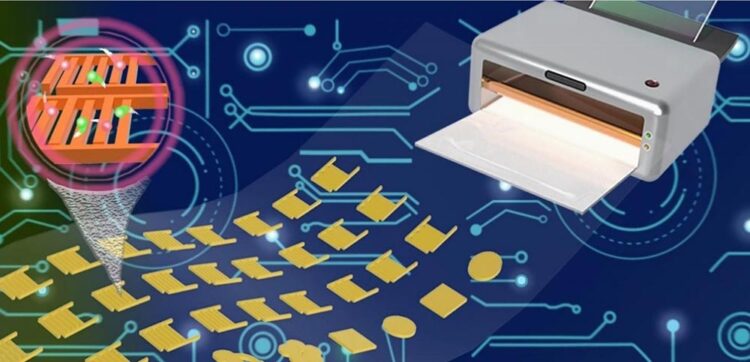Printing flexible wearable electronics for smart device applications

The printed flexible supercapacitor with customized patterns. CREDIT: Wei Wu's group
Credit: Wei Wu's group
Using conventional printing techniques to print flexible supercapacitors is economical, scalable.
The demand for flexible wearable electronics has spiked with the dramatic growth of smart devices that can exchange data with other devices over the internet with embedded sensors, software, and other technologies. Researchers consequently have focused on exploring flexible energy storage devices, such as flexible supercapacitators (FSCs), that are lightweight and safe and easily integrate with other devices. FSCs have high power density and fast charge and discharge rates.
Printing electronics, manufacturing electronics devices and systems by using conventional printing techniques, has proved to be an economical, simple, and scalable strategy for fabricating FSCs. Traditional micromanufacturing techniques can be expensive and complex.
In Applied Physics Reviews, by AIP Publishing, researchers from Wuhan University and Hunan University provide a review of printed FSCs in terms of their ability to formulate functional inks, design printable electrodes, and integrate functions with other electronic devices.
Printed FSCs are generally manufactured by printing the functional inks on traditional organic and inorganic electrode materials on flexible substrates. Due to the thin film structure, these printed devices can be bent, stretched, and twisted to a certain radius without loss of electrochemical function.
In addition, the rigid current collector components of the supercapacitor can also be replaced by the flexible printed parts. Various printing techniques such as screen printing, inkjet printing, and 3D printing have been well established to fabricate the printed FSCs.
“The development of miniaturized, flexible, and planar high-performance electrochemical energy storage devices is an urgent requirement to promote the rapid development of portable electronic devices in daily life,” said author Wu Wei. “We can imagine that in the future, we can use any printer in our lives and can print a supercapacitator to charge a mobile phone or smart wristband at any time.”
The researchers found for printable ink formulations, two principles should be followed. First, when selecting ink components, it is vital to include fewer ineffective additives, better conductive binders, and excellent dispersion electrode materials. Second, the ink must have a suitable viscosity and a good rheology property to obtain excellent prints.
Printable functional materials, such as graphene and pseudocapacitive materials, are good core components of printed supercapacitators.
Since printed electronics offer the advantage of flexibility and low cost, they can be used to manufacture solar cells, flexible OLED displays, transistors, RFID tags, and other integrated smart devices. This opens up the possibility of many other applications, including smart textiles, intelligent packaging, and smart labels.
###
The article “Printed flexible supercapacitor: Ink formulation, printable electrode materials and applications” is authored by Jing Liang, Changzhong Jiang, and Wei Wu. The article appears in Applied Physics Reviews (DOI: 10.1063/5.0048446) and can be accessed at https:/
ABOUT THE JOURNAL
Applied Physics Reviews features articles on significant and current topics in experimental or theoretical research in applied physics, or in applications of physics to other branches of science and engineering. The journal publishes both original research on pioneering studies of broad interest to the applied physics community, and reviews on established or emerging areas of applied physics. See https:/
All latest news from the category: Information Technology
Here you can find a summary of innovations in the fields of information and data processing and up-to-date developments on IT equipment and hardware.
This area covers topics such as IT services, IT architectures, IT management and telecommunications.
Newest articles

Innovative 3D printed scaffolds offer new hope for bone healing
Researchers at the Institute for Bioengineering of Catalonia have developed novel 3D printed PLA-CaP scaffolds that promote blood vessel formation, ensuring better healing and regeneration of bone tissue. Bone is…

The surprising role of gut infection in Alzheimer’s disease
ASU- and Banner Alzheimer’s Institute-led study implicates link between a common virus and the disease, which travels from the gut to the brain and may be a target for antiviral…

Molecular gardening: New enzymes discovered for protein modification pruning
How deubiquitinases USP53 and USP54 cleave long polyubiquitin chains and how the former is linked to liver disease in children. Deubiquitinases (DUBs) are enzymes used by cells to trim protein…



